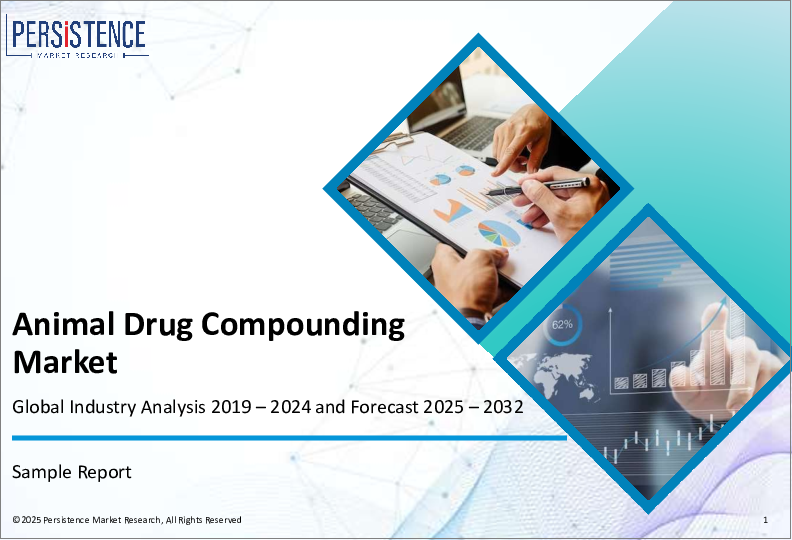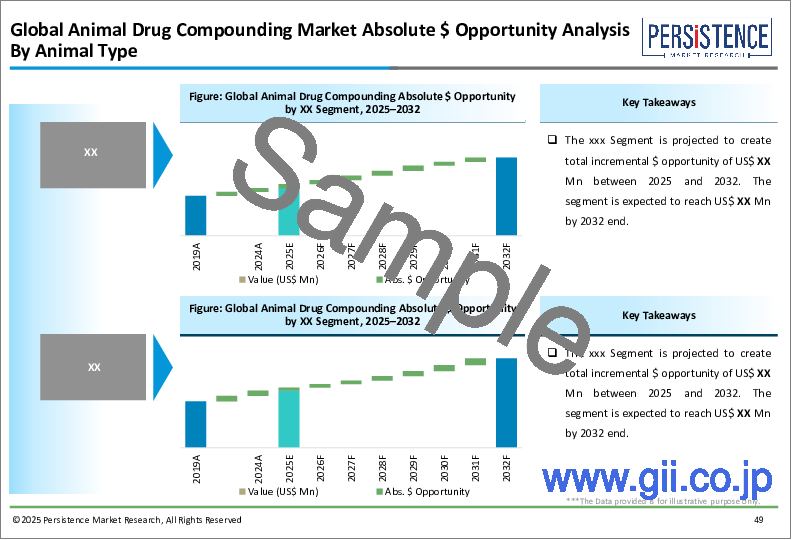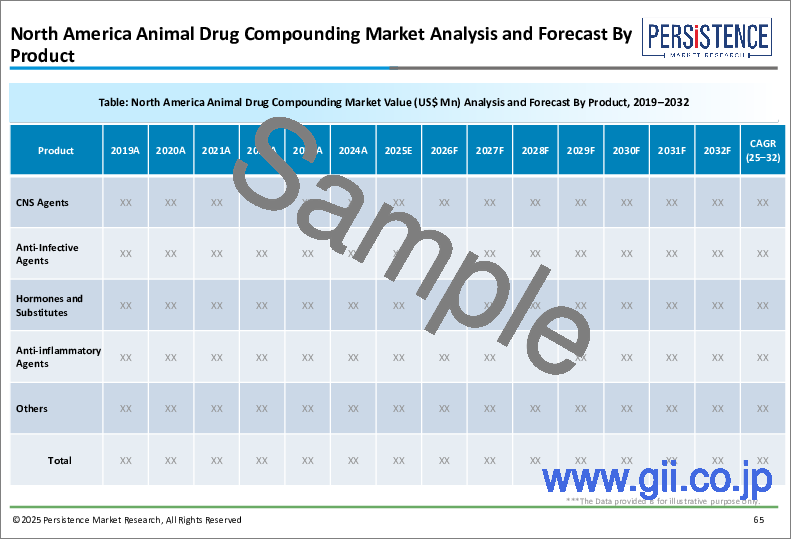|
|
市場調査レポート
商品コード
1697134
動物用医薬品調剤の世界市場:業界分析、規模、シェア、成長、動向、予測(2025年~2032年)Animal Drug Compounding Market: Global Industry Analysis, Size, Share, Growth, Trends, and Forecast, 2025 - 2032 |
||||||
カスタマイズ可能
|
|||||||
| 動物用医薬品調剤の世界市場:業界分析、規模、シェア、成長、動向、予測(2025年~2032年) |
|
出版日: 2025年03月31日
発行: Persistence Market Research
ページ情報: 英文 181 Pages
納期: 2~5営業日
|
- 全表示
- 概要
- 目次
世界の動物用医薬品調剤の市場規模は、2025年に14億米ドルになるとみられ、2025年~2032年の予測期間に6.6%のCAGRで拡大し、2032年には22億米ドルに達すると予測されています。
動物用医薬品調剤には、ペット、家畜、外来種を含む動物の特定のニーズに合わせた薬のカスタマイズが含まれます。この治療プロセスにより、獣医師は投与量の変更、デリバリー方法の変更、アレルギーの原因となる成分の除去など、医薬品の製剤を変更し、治療の有効性と安全性を高めることができます。この市場は、動物病院、調剤薬局、動物病院、研究機関を対象としており、経口懸濁液、風味チュアブル、局所軟膏、注射液など、さまざまな形態の調剤薬を提供しています。市場成長の原動力は、ペットの飼育数の増加、個別化された動物医療に対する需要の高まり、配合薬の安全かつ効果的な使用をサポートする規制の進歩です。
世界の動物用医薬品調剤市場は、関節炎、糖尿病、心血管疾患など、特殊な薬物処方を必要とするペットの慢性疾患の蔓延の増加など、いくつかの重要な要因によって推進されています。ペットのヒューマニゼーション(人間化)の動向の高まりは、質の高い獣医療に対する需要の急増につながり、市場の拡大に拍車をかけています。さらに、特定の動物種や病態に対応する市販の動物用医薬品は限られているため、配合剤による代替が必要とされています。改良された香料技術や無菌調合法などの医薬品調合技術の進歩が、さらに市場拡大に寄与しています。さらに、動物用遠隔医療やeファーマシープラットフォームの拡大により、調剤へのアクセスが容易になり、ペットの飼い主や獣医師にとって治療の利便性が向上しています。
有望な成長見通しにもかかわらず、動物用医薬品調剤市場は規制遵守、品質管理、価格制約に関する課題に直面しています。特に米国食品医薬品局(FDA)や世界各国の同様の規制機関による動物用医薬品の調合に関する厳しい規制は、調合薬局や獣医診療所に業務上の負担を課しています。さらに、特に適正製造基準(GMP)を遵守せずに製造された場合、配合薬の安全性と有効性に関する懸念が、市場導入の課題となっています。また、市販の代替品と比較して配合薬のコストが高いため、特に価格に敏感な市場においては、ペットの飼い主や畜産農家にとって購入しやすい価格に制限される可能性があります。これらの課題に対処するためには、コンプライアンス、品質保証、アクセシビリティを確保するために、規制当局、獣医専門家、および医薬品配合の利害関係者が協力して取り組む必要があります。
動物用医薬品調剤市場は、動物医療の革新、個別化されたペットヘルスケアに対する意識の高まり、調合薬局ネットワークの拡大により、大きな成長機会をもたらしています。特定の動物種、動物種、病状に合わせた新規製剤の開発は、調剤サービスプロバイダーに新たな収益源を生み出します。さらに、徐放性製剤や経皮ドラッグデリバリーなどの高度な調剤技術の研究開発(R&D)への投資が増加し、治療成績と市場の可能性が高まっています。AIを活用した処方システムやブロックチェーンを活用した投薬追跡などのデジタルヘルス技術の統合は、動物用医薬品の調合プロセスをさらに最適化します。さらに、調剤薬局と動物病院間のパートナーシップは、市場浸透を強化し、独自のヘルスケアニーズを持つ動物にカスタマイズされた治療オプションを提供することができます。
当レポートでは、世界の動物用医薬品調剤市場について調査し、製品別、動物別、剤形別、地域別動向、および市場に参入する企業のプロファイルなどを提供しています。
目次
第1章 エグゼクティブサマリー
第2章 市場概要
- 市場の範囲と定義
- 市場力学
- マクロ経済要因
- COVID-19の影響分析
- 予測要因- 関連性と影響
第3章 付加価値の洞察
第4章 世界の動物用医薬品調剤市場の見通し:実績(2019年~2024年)および予測(2025年~2032年)
- 主なハイライト
- 市場規模の分析と予測
- 過去の市場規模分析、2019年~2024年
- 現在の市場規模の分析と予測、2025年~2032年
- 世界の動物用医薬品調剤市場の見通し:製品別
- イントロダクション/主な調査結果
- 過去の市場規模分析、製品別、2019年~2024年
- 現在の市場規模分析と予測、製品別、2025年~2032年
- 市場の魅力分析:製品
- 世界の動物用医薬品調剤市場の見通し:動物別
- イントロダクション/主な調査結果
- 過去の市場規模分析、動物別、2019年~2024年
- 現在の市場規模分析と予測、動物別、2025年~2032年
- 市場の魅力分析:動物別
- 世界の動物用医薬品調剤市場の見通し:剤形別
- イントロダクション/主な調査結果
- 過去の市場規模分析、剤形別、2019年~2024年
- 現在の市場規模分析と予測、剤形別、2025年~2032年
- 市場の魅力分析:剤形別
第5章 世界の動物用医薬品調剤市場の見通し:地域別
- 主なハイライト
- 過去の市場規模分析、地域別、2019年~2024年
- 現在の市場規模分析と予測、地域別、2025年~2032年
- 北米
- 欧州
- 東アジア
- 南アジアとオセアニア
- ラテンアメリカ
- 中東・アフリカ
- 市場の魅力分析:地域別
第6章 北米の動物用医薬品調剤市場の見通し:実績(2019年~2024年)および予測(2025年~2032年)
第7章 欧州の動物用医薬品調剤市場の見通し:実績(2019年~2024年)および予測(2025年~2032年)
第8章 東アジアの動物用医薬品調剤市場の見通し:実績(2019年~2024年)および予測(2025年~2032年)
第9章 南アジアおよびオセアニアの動物用医薬品調剤市場の見通し:実績(2019年~2024年)および予測(2025年~2032年)
第10章 ラテンアメリカの動物用医薬品調剤市場の見通し:実績(2019年~2024年)および予測(2025年~2032年)
第11章 中東・アフリカの動物用医薬品調剤市場の見通し:実績(2019年~2024年)および予測(2025年~2032年)
第12章 競合情勢
- 市場シェア分析、2025年
- 市場構造
- 企業プロファイル(詳細- 概要、財務、戦略、最近の動向)
- Hoye's Pharmacy
- Vertisis Custom Pharmacy
- Smith Caldwell Drug Store
- Sixth Avenue Medical Pharmacy
- Dougherty's Pharmacy
- Triangle Compounding Pharmacy Inc.
- Medisca Inc.
- Wedgewood Pharmacy
- Millers Pharmacy
- Chiron Compounding Pharmacy
- MEDS Canadian Compounding Pharmacy
- Aurora Compounding
- Pace Pharmacy
- Victoria Compounding Pharmacy
- Pratt's Compounding Pharmacy
- People's Choice Pharmacy
第13章 付録
Persistence Market Research has recently released a comprehensive report on the worldwide market for animal drug compounding. The report offers a thorough assessment of crucial market dynamics, including drivers, trends, opportunities, and challenges, providing detailed insights into the market structure. This research publication presents exclusive data and statistics outlining the anticipated growth trajectory of the global animal drug compounding market from 2025 to 2032.
Key Insights:
- Animal Drug Compounding Market Size (2025E): USD 1.4 Billion
- Projected Market Value (2032F): USD 2.2 Billion
- Global Market Growth Rate (CAGR 2025 to 2032): 6.6%
Animal Drug Compounding Market - Report Scope:
Animal drug compounding involves the customization of medications tailored to the specific needs of animals, including pets, livestock, and exotic species. This process enables veterinarians to modify drug formulations by altering dosages, changing delivery methods, or removing allergenic ingredients to enhance treatment efficacy and safety. The market caters to veterinary clinics, compounding pharmacies, animal hospitals, and research institutions, offering compounded medications in various forms, such as oral suspensions, flavored chewables, topical ointments, and injectable solutions. Market growth is driven by increasing pet ownership, rising demand for personalized veterinary care, and regulatory advancements that support the safe and effective use of compounded drugs.
Market Growth Drivers:
The global animal drug compounding market is propelled by several key factors, including the growing prevalence of chronic diseases in pets, such as arthritis, diabetes, and cardiovascular conditions, which require specialized medication formulations. The increasing trend of pet humanization has led to a surge in demand for high-quality veterinary care, fueling market expansion. Additionally, the limited availability of commercial veterinary drugs for specific species and conditions creates a need for compounded alternatives. Advancements in pharmaceutical compounding technologies, such as improved flavoring techniques and sterile compounding methods, further contribute to market growth. Moreover, the expansion of veterinary telemedicine and e-pharmacy platforms facilitates easier access to compounded medications, enhancing treatment convenience for pet owners and veterinarians alike.
Market Restraints:
Despite promising growth prospects, the animal drug compounding market faces challenges related to regulatory compliance, quality control, and pricing constraints. Stringent regulations governing the compounding of veterinary drugs, particularly by the U.S. Food and Drug Administration (FDA) and similar regulatory bodies worldwide, impose operational burdens on compounding pharmacies and veterinary practices. Additionally, concerns regarding the safety and efficacy of compounded drugs, especially when produced without adherence to Good Manufacturing Practices (GMP), pose challenges for market adoption. The higher cost of compounded medications compared to commercially available alternatives may also limit their affordability for pet owners and livestock farmers, particularly in price-sensitive markets. Addressing these challenges requires collaborative efforts between regulatory agencies, veterinary professionals, and pharmaceutical compounding stakeholders to ensure compliance, quality assurance, and accessibility.
Market Opportunities:
The animal drug compounding market presents significant growth opportunities driven by innovations in veterinary medicine, rising awareness about personalized pet healthcare, and the expansion of compounding pharmacy networks. The development of novel drug formulations tailored for specific animal breeds, species, and medical conditions creates new revenue streams for compounding service providers. Additionally, increasing investments in research and development (R&D) for advanced compounding techniques, such as sustained-release formulations and transdermal drug delivery, enhance treatment outcomes and market potential. The integration of digital health technologies, including AI-driven prescription systems and blockchain-based medication tracking, further optimizes veterinary drug compounding processes. Furthermore, partnerships between compounding pharmacies and veterinary clinics can strengthen market penetration, offering customized treatment options for animals with unique healthcare needs.
Key Questions Answered in the Report:
- What are the primary factors driving the growth of the animal drug compounding market globally?
- Which drug types and administration methods are witnessing increased adoption in veterinary compounding?
- How are technological advancements reshaping the competitive landscape of the animal drug compounding market?
- Who are the key players contributing to the market, and what strategies are they employing to maintain market relevance?
- What are the emerging trends and future prospects in the global animal drug compounding market?
Competitive Intelligence and Business Strategy:
Leading players in the global animal drug compounding market, including Wedgewood Pharmacy, Diamondback Drugs, and Medisca, focus on innovation, regulatory compliance, and strategic collaborations to gain a competitive edge. These companies invest in R&D to develop advanced compounding solutions, such as palatable veterinary drugs, precision dosing techniques, and bioequivalent formulations. Partnerships with veterinary organizations, pet clinics, and online pet pharmacies facilitate market expansion and enhance consumer awareness about compounded medications. Moreover, emphasis on quality control, adherence to regulatory standards, and continuous training of veterinary pharmacists drive market credibility and consumer trust.
Key Companies Profiled:
- Wedgewood Pharmacy
- Diamondback Drugs
- Medisca
- Letco Medical
- Covetrus, Inc.
- Aurora Pharmaceutical
- BCP Veterinary Pharmacy
- Stokes Pharmacy
- Epicur Pharma
- Drexel Pharmaceuticals
Animal Drug Compounding Industry Segmentation
By Product
- CNS Agents
- Anti-Infective Agents
- Hormones and Substitutes
- Anti-inflammatory Agents
By Animal
- Companion
- Livestock
By Formulation
- Oral
- Injectable
Region
- North America
- Latin America
- Europe
- East Asia
- South Asia
- Oceania
Table of Contents
1. Executive Summary
- 1.1. Global Animal Drug Compounding Market Snapshot, 2025-2032
- 1.2. Market Opportunity Assessment, 2025-2032, US$ Bn
- 1.3. Key Market Trends
- 1.4. Future Market Projections
- 1.5. Premium Market Insights
- 1.6. Industry Developments and Key Market Events
- 1.7. PMR Analysis and Recommendations
2. Market Overview
- 2.1. Market Scope and Definition
- 2.2. Market Dynamics
- 2.2.1. Drivers
- 2.2.2. Restraints
- 2.2.3. Opportunity
- 2.2.4. Challenges
- 2.2.5. Key Trends
- 2.3. Macro-Economic Factors
- 2.3.1. Global Sectorial Outlook
- 2.3.2. Global GDP Growth Outlook
- 2.4. COVID-19 Impact Analysis
- 2.5. Forecast Factors - Relevance and Impact
3. Value Added Insights
- 3.1. Regulatory Landscape
- 3.2. Product Adoption Analysis
- 3.3. Value Chain Analysis
- 3.4. Key Deals and Mergers
- 3.5. PESTLE Analysis
- 3.6. Porter's Five Force Analysis
4. Global Animal Drug Compounding Market Outlook: Historical (2019-2024) and Forecast (2025-2032)
- 4.1. Key Highlights
- 4.1.1. Market Size (US$ Bn) and Y-o-Y Growth
- 4.1.2. Absolute $ Opportunity
- 4.2. Market Size (US$ Bn) Analysis and Forecast
- 4.2.1. Historical Market Size (US$ Bn) Analysis, 2019-2024
- 4.2.2. Current Market Size (US$ Bn) Analysis and Forecast, 2025-2032
- 4.3. Global Animal Drug Compounding Market Outlook: Product
- 4.3.1. Introduction / Key Findings
- 4.3.2. Historical Market Size (US$ Bn) Analysis, By Product, 2019-2024
- 4.3.3. Current Market Size (US$ Bn) Analysis and Forecast, By Product, 2025-2032
- 4.3.3.1. CNS Agents
- 4.3.3.2. Anti-Infective Agents
- 4.3.3.3. Hormones and Substitutes
- 4.3.3.4. Anti-inflammatory Agents
- 4.3.3.5. Others
- 4.3.4. Market Attractiveness Analysis: Product
- 4.4. Global Animal Drug Compounding Market Outlook: Animal
- 4.4.1. Introduction / Key Findings
- 4.4.2. Historical Market Size (US$ Bn) Analysis, By Animal, 2019-2024
- 4.4.3. Current Market Size (US$ Bn) Analysis and Forecast, By Animal, 2025-2032
- 4.4.3.1. Companion
- 4.4.3.1.1. Cats
- 4.4.3.1.2. Dogs
- 4.4.3.1.3. Others
- 4.4.3.2. Livestock
- 4.4.3.1. Companion
- 4.4.4. Market Attractiveness Analysis: Animal
- 4.5. Global Animal Drug Compounding Market Outlook: Formulation
- 4.5.1. Introduction / Key Findings
- 4.5.2. Historical Market Size (US$ Bn) Analysis, By Formulation, 2019-2024
- 4.5.3. Current Market Size (US$ Bn) Analysis and Forecast, By Formulation, 2025-2032
- 4.5.3.1. Oral
- 4.5.3.2. Injectable
- 4.5.3.3. Others
- 4.5.4. Market Attractiveness Analysis: Formulation
5. Global Animal Drug Compounding Market Outlook: Region
- 5.1. Key Highlights
- 5.2. Historical Market Size (US$ Bn) Analysis, By Region, 2019-2024
- 5.3. Current Market Size (US$ Bn) Analysis and Forecast, By Region, 2025-2032
- 5.3.1. North America
- 5.3.2. Europe
- 5.3.3. East Asia
- 5.3.4. South Asia and Oceania
- 5.3.5. Latin America
- 5.3.6. Middle East & Africa
- 5.4. Market Attractiveness Analysis: Region
6. North America Animal Drug Compounding Market Outlook: Historical (2019-2024) and Forecast (2025-2032)
- 6.1. Key Highlights
- 6.2. Historical Market Size (US$ Bn) Analysis, By Market, 2019-2024
- 6.2.1. By Country
- 6.2.2. By Product
- 6.2.3. By Animal
- 6.2.4. By Formulation
- 6.3. Current Market Size (US$ Bn) Analysis and Forecast, By Country, 2025-2032
- 6.3.1. U.S.
- 6.3.2. Canada
- 6.4. Current Market Size (US$ Bn) Analysis and Forecast, By Product, 2025-2032
- 6.4.1. CNS Agents
- 6.4.2. Anti-Infective Agents
- 6.4.3. Hormones and Substitutes
- 6.4.4. Anti-inflammatory Agents
- 6.4.5. Others
- 6.5. Current Market Size (US$ Bn) Analysis and Forecast, By Animal, 2025-2032
- 6.5.1. Companion
- 6.5.1.1. Cats
- 6.5.1.2. Dogs
- 6.5.1.3. Others
- 6.5.2. Livestock
- 6.5.1. Companion
- 6.6. Current Market Size (US$ Bn) Analysis and Forecast, By Formulation, 2025-2032
- 6.6.1. Oral
- 6.6.2. Injectable
- 6.6.3. Others
- 6.7. Market Attractiveness Analysis
7. Europe Animal Drug Compounding Market Outlook: Historical (2019-2024) and Forecast (2025-2032)
- 7.1. Key Highlights
- 7.2. Historical Market Size (US$ Bn) Analysis, By Market, 2019-2024
- 7.2.1. By Country
- 7.2.2. By Product
- 7.2.3. By Animal
- 7.2.4. By Formulation
- 7.3. Current Market Size (US$ Bn) Analysis and Forecast, By Country, 2025-2032
- 7.3.1. Germany
- 7.3.2. France
- 7.3.3. U.K.
- 7.3.4. Italy
- 7.3.5. Spain
- 7.3.6. Russia
- 7.3.7. Turkey
- 7.3.8. Rest of Europe
- 7.4. Current Market Size (US$ Bn) Analysis and Forecast, By Product, 2025-2032
- 7.4.1. CNS Agents
- 7.4.2. Anti-Infective Agents
- 7.4.3. Hormones and Substitutes
- 7.4.4. Anti-inflammatory Agents
- 7.4.5. Others
- 7.5. Current Market Size (US$ Bn) Analysis and Forecast, By Animal, 2025-2032
- 7.5.1. Companion
- 7.5.1.1. Cats
- 7.5.1.2. Dogs
- 7.5.1.3. Others
- 7.5.2. Livestock
- 7.5.1. Companion
- 7.6. Current Market Size (US$ Bn) Analysis and Forecast, By Formulation, 2025-2032
- 7.6.1. Oral
- 7.6.2. Injectable
- 7.6.3. Others
- 7.7. Market Attractiveness Analysis
8. East Asia Animal Drug Compounding Market Outlook: Historical (2019-2024) and Forecast (2025-2032)
- 8.1. Key Highlights
- 8.2. Historical Market Size (US$ Bn) Analysis, By Market, 2019-2024
- 8.2.1. By Country
- 8.2.2. By Product
- 8.2.3. By Animal
- 8.2.4. By Formulation
- 8.3. Current Market Size (US$ Bn) Analysis and Forecast, By Country, 2025-2032
- 8.3.1. China
- 8.3.2. Japan
- 8.3.3. South Korea
- 8.4. Current Market Size (US$ Bn) Analysis and Forecast, By Product, 2025-2032
- 8.4.1. CNS Agents
- 8.4.2. Anti-Infective Agents
- 8.4.3. Hormones and Substitutes
- 8.4.4. Anti-inflammatory Agents
- 8.4.5. Others
- 8.5. Current Market Size (US$ Bn) Analysis and Forecast, By Animal, 2025-2032
- 8.5.1. Companion
- 8.5.1.1. Cats
- 8.5.1.2. Dogs
- 8.5.1.3. Others
- 8.5.2. Livestock
- 8.5.1. Companion
- 8.6. Current Market Size (US$ Bn) Analysis and Forecast, By Formulation, 2025-2032
- 8.6.1. Oral
- 8.6.2. Injectable
- 8.6.3. Others
- 8.7. Market Attractiveness Analysis
9. South Asia & Oceania Animal Drug Compounding Market Outlook: Historical (2019-2024) and Forecast (2025-2032)
- 9.1. Key Highlights
- 9.2. Historical Market Size (US$ Bn) Analysis, By Market, 2019-2024
- 9.2.1. By Country
- 9.2.2. By Product
- 9.2.3. By Animal
- 9.2.4. By Formulation
- 9.3. Current Market Size (US$ Bn) Analysis and Forecast, By Country, 2025-2032
- 9.3.1. India
- 9.3.2. Southeast Asia
- 9.3.3. ANZ
- 9.3.4. Rest of South Asia & Oceania
- 9.4. Current Market Size (US$ Bn) Analysis and Forecast, By Product, 2025-2032
- 9.4.1. CNS Agents
- 9.4.2. Anti-Infective Agents
- 9.4.3. Hormones and Substitutes
- 9.4.4. Anti-inflammatory Agents
- 9.4.5. Others
- 9.5. Current Market Size (US$ Bn) Analysis and Forecast, By Animal, 2025-2032
- 9.5.1. Companion
- 9.5.1.1. Cats
- 9.5.1.2. Dogs
- 9.5.1.3. Others
- 9.5.2. Livestock
- 9.5.1. Companion
- 9.6. Current Market Size (US$ Bn) Analysis and Forecast, By Formulation, 2025-2032
- 9.6.1. Oral
- 9.6.2. Injectable
- 9.6.3. Others
- 9.7. Market Attractiveness Analysis
10. Latin America Animal Drug Compounding Market Outlook: Historical (2019-2024) and Forecast (2025-2032)
- 10.1. Key Highlights
- 10.2. Historical Market Size (US$ Bn) Analysis, By Market, 2019-2024
- 10.2.1. By Country
- 10.2.2. By Product
- 10.2.3. By Animal
- 10.2.4. By Formulation
- 10.3. Current Market Size (US$ Bn) Analysis and Forecast, By Country, 2025-2032
- 10.3.1. Brazil
- 10.3.2. Mexico
- 10.3.3. Rest of Latin America
- 10.4. Current Market Size (US$ Bn) Analysis and Forecast, By Product, 2025-2032
- 10.4.1. CNS Agents
- 10.4.2. Anti-Infective Agents
- 10.4.3. Hormones and Substitutes
- 10.4.4. Anti-inflammatory Agents
- 10.4.5. Others
- 10.5. Current Market Size (US$ Bn) Analysis and Forecast, By Animal, 2025-2032
- 10.5.1. Companion
- 10.5.1.1. Cats
- 10.5.1.2. Dogs
- 10.5.1.3. Others
- 10.5.2. Livestock
- 10.5.1. Companion
- 10.6. Current Market Size (US$ Bn) Analysis and Forecast, By Formulation, 2025-2032
- 10.6.1. Oral
- 10.6.2. Injectable
- 10.6.3. Others
- 10.7. Market Attractiveness Analysis
11. Middle East & Africa Animal Drug Compounding Market Outlook: Historical (2019-2024) and Forecast (2025-2032)
- 11.1. Key Highlights
- 11.2. Historical Market Size (US$ Bn) Analysis, By Market, 2019-2024
- 11.2.1. By Country
- 11.2.2. By Product
- 11.2.3. By Animal
- 11.2.4. By Formulation
- 11.3. Current Market Size (US$ Bn) Analysis and Forecast, By Country, 2025-2032
- 11.3.1. GCC Countries
- 11.3.2. Egypt
- 11.3.3. South Africa
- 11.3.4. Northern Africa
- 11.3.5. Rest of Middle East & Africa
- 11.4. Current Market Size (US$ Bn) Analysis and Forecast, By Product, 2025-2032
- 11.4.1. CNS Agents
- 11.4.2. Anti-Infective Agents
- 11.4.3. Hormones and Substitutes
- 11.4.4. Anti-inflammatory Agents
- 11.4.5. Others
- 11.5. Current Market Size (US$ Bn) Analysis and Forecast, By Animal, 2025-2032
- 11.5.1. Companion
- 11.5.1.1. Cats
- 11.5.1.2. Dogs
- 11.5.1.3. Others
- 11.5.2. Livestock
- 11.5.1. Companion
- 11.6. Current Market Size (US$ Bn) Analysis and Forecast, By Formulation, 2025-2032
- 11.6.1. Oral
- 11.6.2. Injectable
- 11.6.3. Others
- 11.7. Market Attractiveness Analysis
12. Competition Landscape
- 12.1. Market Share Analysis, 2025
- 12.2. Market Structure
- 12.2.1. Competition Intensity Mapping By Market
- 12.2.2. Competition Dashboard
- 12.3. Company Profiles (Details - Overview, Financials, Strategy, Recent Developments)
- 12.3.1. Hoye's Pharmacy
- 12.3.1.1. Overview
- 12.3.1.2. Segments and Products
- 12.3.1.3. Key Financials
- 12.3.1.4. Market Developments
- 12.3.1.5. Market Strategy
- 12.3.2. Vertisis Custom Pharmacy
- 12.3.3. Smith Caldwell Drug Store
- 12.3.4. Sixth Avenue Medical Pharmacy
- 12.3.5. Dougherty's Pharmacy
- 12.3.6. Triangle Compounding Pharmacy Inc.
- 12.3.7. Medisca Inc.
- 12.3.8. Wedgewood Pharmacy
- 12.3.9. Millers Pharmacy
- 12.3.10. Chiron Compounding Pharmacy
- 12.3.11. MEDS Canadian Compounding Pharmacy
- 12.3.12. Aurora Compounding
- 12.3.13. Pace Pharmacy
- 12.3.14. Victoria Compounding Pharmacy
- 12.3.15. Pratt's Compounding Pharmacy
- 12.3.16. People's Choice Pharmacy
- 12.3.1. Hoye's Pharmacy
13. Appendix
- 13.1. Research Methodology
- 13.2. Research Assumptions
- 13.3. Acronyms and Abbreviations






